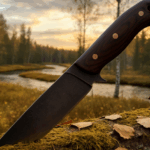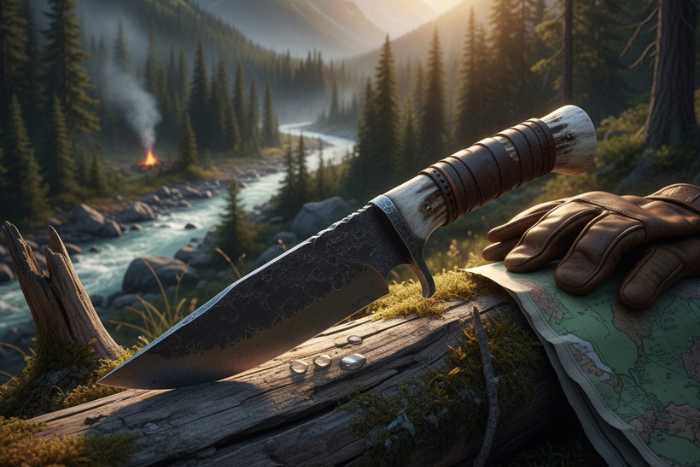

The old timer at the sporting goods store looked at my brand-new hunting knife with barely concealed amusement. I’d spent an hour comparing options, reading specifications, and ultimately choosing what looked impressive in the display case.
“Nice knife,” he said, his tone suggesting otherwise. “Let me know how it works for you.”
Three days into my first serious hunting trip, I understood his skepticism. The knife looked great. It felt substantial in my hand. But when it came time to actually use it field dressing a deer in cold, wet conditions every design flaw became painfully apparent. The handle was slippery. The blade geometry was wrong for the task. And I learned an expensive lesson about the difference between a knife that looks like a hunting knife and one that actually performs like one.
Selecting the right hunting knife isn’t about finding the most tactical-looking blade or the one with the most features. It’s about understanding what you’ll actually be doing in the field and choosing a tool designed specifically for those tasks. A knife that’s perfect for elk hunting in the Rockies might be completely wrong for whitetail hunting in Tennessee hardwoods.
The first question isn’t “what knife should I buy?” It’s “what will I be hunting, and what tasks will this knife need to perform?” A small game hunter needs different blade characteristics than someone pursuing large game. Someone who only field dresses animals and transports them whole has different requirements than a hunter who does complete field processing, including quartering and deboning.
Blade length matters more than most people realize. The common assumption is that bigger is better more blade means more capability. But in actual hunting scenarios, blade length involves tradeoffs. A longer blade provides more cutting edge and can handle larger cutting tasks, but it’s also heavier, more cumbersome, and harder to control for detailed work.
For most hunting applications, a blade between three and five inches hits the sweet spot. It’s long enough to handle field dressing and basic processing, yet short enough to maintain control during precise cuts. Some hunters carry two knives a larger blade for initial field work and a smaller one for detail tasks but for those who prefer carrying minimal gear, a four-inch blade represents the best compromise.
Blade shape significantly affects functionality. The drop point design where the spine of the blade curves gently down to meet the edge is probably the most versatile hunting knife profile. The reinforced tip provides strength for piercing, while the broad belly offers plenty of cutting edge. The design minimizes accidental punctures when working inside body cavities, a practical consideration that becomes important when you’re field dressing in less-than-ideal conditions.
Clip point blades, where the spine has a concave curve creating a finer tip, offer superior piercing ability and work well for hunters who need to make precise initial cuts. The trade-off is a slightly weaker tip that’s more prone to breaking if you hit bone or use the knife for prying.
Trailing point blades, with the spine curving upward, excel at slicing and skinning tasks. The extended cutting edge makes them efficient for processing, though the upward-curving tip takes some getting used to for hunters accustomed to drop point designs.
Handle design separates functional hunting knives from display pieces. When you’re field dressing an animal, your hands might be cold, wet, or bloody. The handle needs to provide secure grip under these conditions without causing fatigue during extended use. Smooth, polished handles that look beautiful in a display case become dangerously slippery in actual hunting conditions.
Traditional materials like wood and bone offer excellent grip characteristics, especially when properly textured. They also provide that connection to hunting heritage that many hunters value. Modern synthetic materials like G10 or Micarta offer superior durability and weather resistance while maintaining good grip, even when wet.
Handle shape matters as much as material. The handle should fill your hand comfortably without pressure points that cause fatigue. Some hunters prefer handles with pronounced finger grooves, while others find these restrictive. The best approach is to actually hold the knife and imagine using it for extended periods, not just admiring how it looks.
Full tang construction where the blade steel extends through the entire handle—provides superior strength and durability. This matters when you’re using your knife for demanding tasks in remote locations where equipment failure isn’t just inconvenient, it’s potentially dangerous. Partial tang knives might be lighter and less expensive, but for serious hunting applications, the strength advantage of full tang construction is worth the extra weight and cost.
The steel selection for hunting knives involves balancing several factors. Carbon steel offers excellent edge retention and is easier to sharpen in the field using basic tools. The downside is corrosion susceptibility carbon steel requires regular maintenance and can rust if not properly cared for after exposure to blood and moisture.
Stainless steel provides better corrosion resistance with less maintenance, appealing to hunters who want reliability without constant care. Modern stainless steels have largely closed the performance gap with carbon steel, though some hunters still prefer carbon steel’s edge characteristics.
Sheath design deserves as much consideration as the knife itself. A hunting knife spends most of its time in the sheath, and how it carries affects everything from comfort to accessibility. Leather sheaths offer traditional appeal and quiet carry, though they require maintenance and can retain moisture. Modern Kydex sheaths provide excellent retention, weather resistance, and durability, though they’re noisier and less traditional.
The carry position matters enormously. Some hunters prefer belt carry, keeping the knife readily accessible. Others choose drop-leg or chest carry for different accessibility and comfort characteristics. The best carry method depends on your hunting style, the terrain you’ll be navigating, and personal preference.
Fixed blade versus folding knife represents another fundamental choice. Fixed blades offer superior strength, reliability, and ease of cleaning critical factors when you’re depending on your knife in challenging conditions. Folding knives provide compactness and convenience, appealing to hunters who prioritize minimal gear.
For serious hunting applications, most experienced hunters choose fixed blades. The mechanical simplicity means less that can fail. The lack of moving parts means easier cleaning after processing game. And the inherent strength of a fixed blade provides confidence when performing demanding cutting tasks.
Knife maintenance in the field requires consideration during selection. A knife that’s difficult to sharpen or clean becomes a liability during extended hunting trips. Some blade steels hold an edge longer but are difficult to sharpen without specialized equipment. Others sharpen easily but require more frequent attention.
For backcountry hunting where you might be away from civilization for days or weeks, the ability to maintain your knife with basic tools becomes crucial. This often tips the selection toward more traditional steels and simpler designs that can be maintained with a whetstone and basic care.
The perfect hunting knife doesn’t exist there are only knives well-suited to specific hunting applications and personal preferences. A knife that’s ideal for one hunter might be completely wrong for another, even if they’re hunting the same game in the same conditions. This is why experienced hunters often own multiple knives, choosing the right tool for each specific situation.
What matters most is honest assessment of your actual needs, not what looks impressive or what someone else recommends. Consider the game you hunt, the processing you’ll do in the field, the conditions you’ll face, and your own preferences regarding size, weight, and maintenance requirements.
Selecting a hunting knife is ultimately about choosing a tool that will perform reliably when it matters most in challenging conditions, far from help, when you need to efficiently process game and get meat safely transported. It’s about finding that balance between capability and practicality, between traditional appeal and modern performance, between what looks good and what works well.
The knife that serves you best might not be the most expensive or the most impressive-looking. It’s the one that fits your hand comfortably, performs the tasks you need, and becomes so familiar that using it feels natural rather than conscious. That’s when a hunting knife transcends being just a tool and becomes an essential part of your outdoor experience.
JWBS Knives provides exceptional hand forged knives, delivering quality craftsmanship and precision engineering for knife enthusiasts and professionals.
Contact JWBS Knives:
📞 615-406-6370
📧 Info@jwbsknives.com
🌐 https://jwbsknives.com
📘 Facebook
📸 Instagram
Specialties: Hand-forged knives, custom knife design, collector pieces, professional-grade outdoor and survival blades.
Ready to Find Your Perfect Hunting Knife?
Contact JWBS Knives today!
Join our newsletter and stay up to date on all the custom products jwbsknives has to offer and read about custom techniques we use in the Forging Process of your next Hand Crafted Knife and Accessories.
After order is placed we will contact you about shipping cost with your choice of carrier.